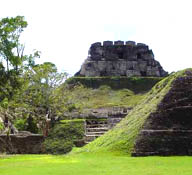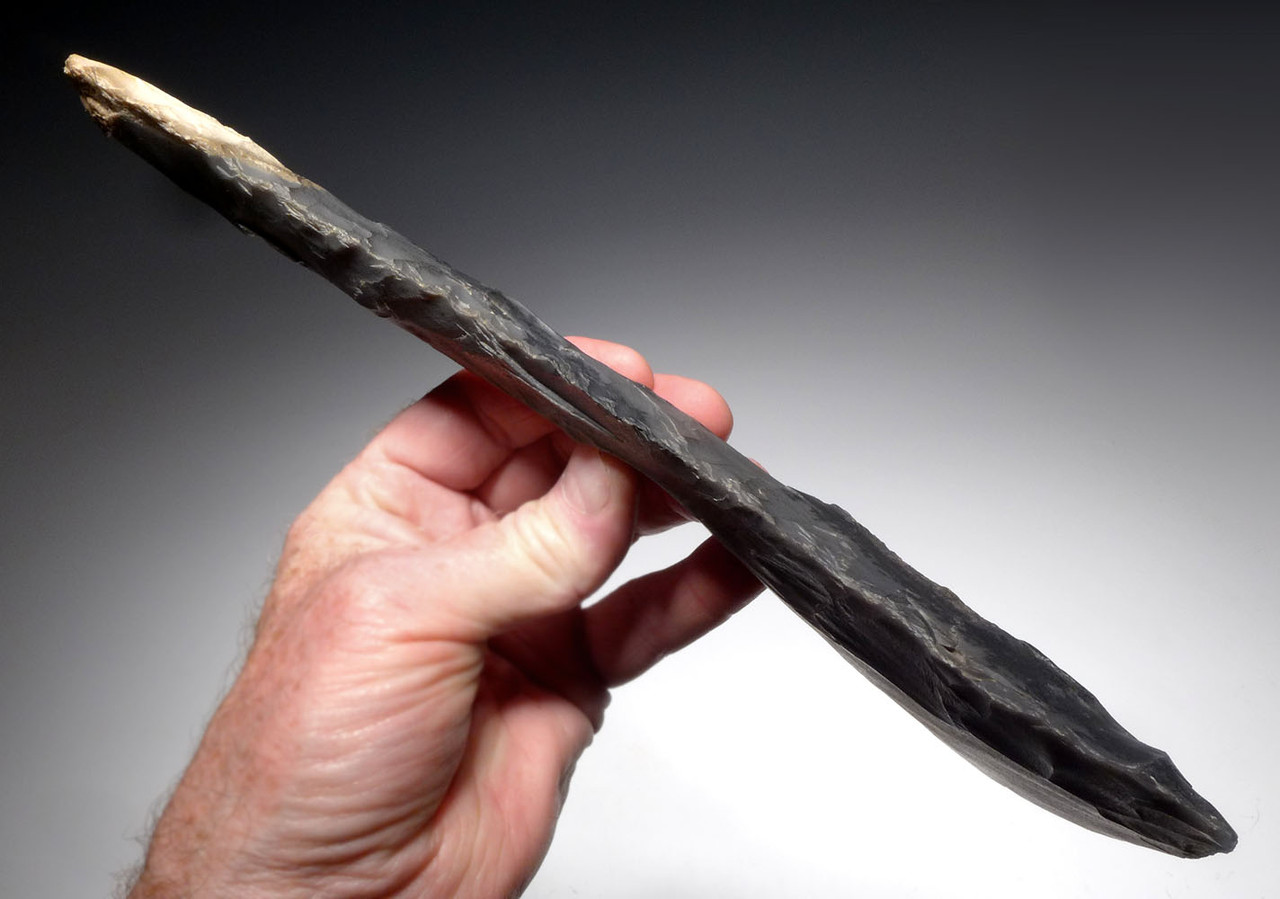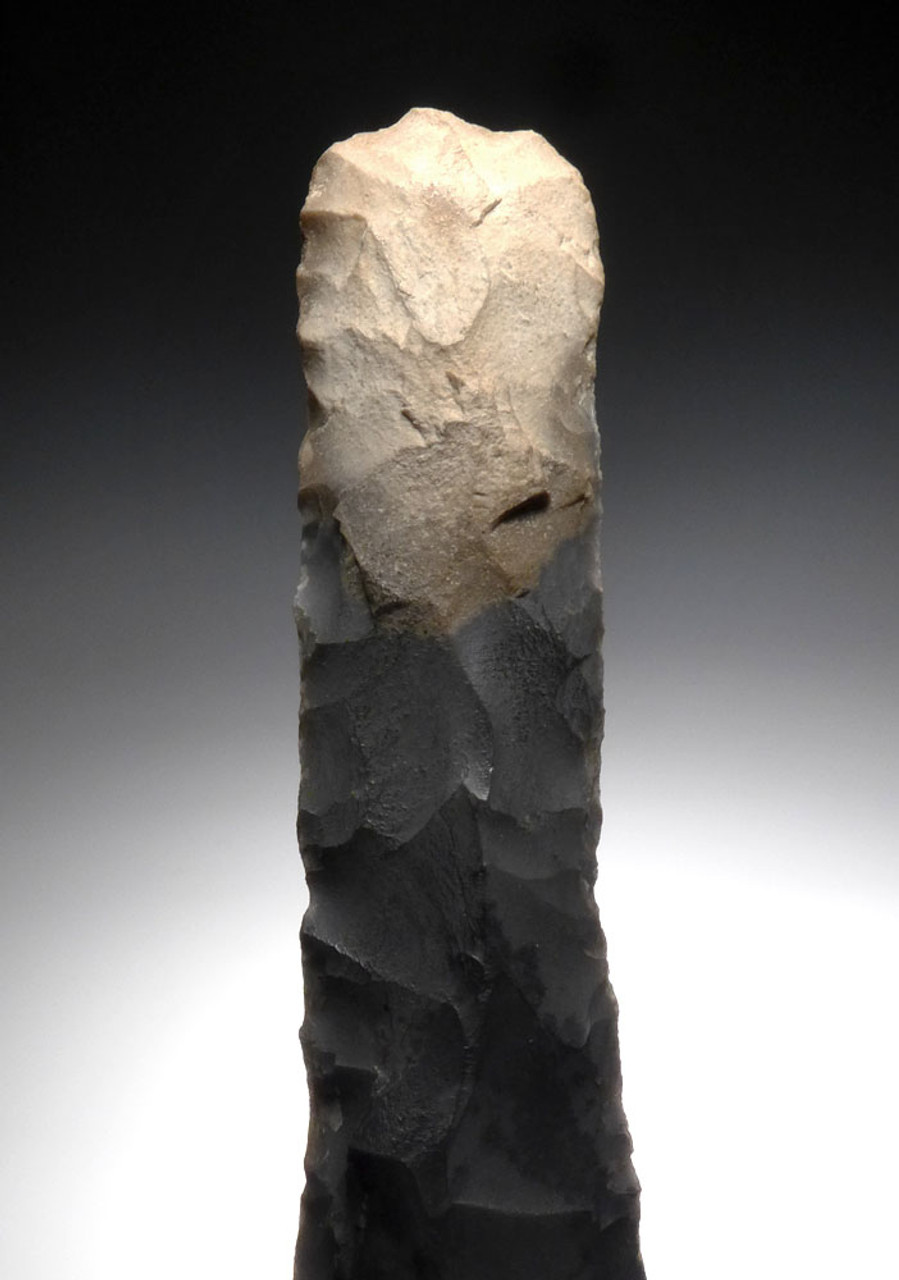Product Description
SEE MORE PRE-COLUMBIAN TOOLS AND WEAPONS
For discriminating collectors of rare Mayan prestige weapons, this is a massive, MUSEUM-CLASS flaked ceremonial stemmed flaked axe made of chert. In 22+ years of extensive collecting and handling this material, we have yet to see a weapon of this type ever rival this specimen. It is functional but the nature of its design does not lend itself to routine war use. It is simply too well-made and most likely the long stem would not have survived the clash of battle. The ritual of human sacrifice and decapitation of victims of the Mayan culture is well-documented and an axe of this type would have been ideally suited for actual use in that task. Codices and a wealth of ancient artifacts depict ritual Mayan decapitation of the victims as a highly revered ceremony, often to commemorate an important event or god. In order to swiftly accomplish this, an axe like this would have been needed. As a ceremonial weapon, it would not be commonly seen in the typical array of known warfare weapon typology. The robust nature of this axe shows it was not merely for display - its heft and strength of design is highly functional. Controlled use in a human sacrifice setting would protect it from the typical damage of the struggle and chaos of combat since those it was used on were already deceased or subdued. See below for more information regarding Mayan decapitation sacrifice.
Made from a single giant piece of chert, this long-stemmed axe was masterfully bifacially flaked with a heavy, broad flared chopping end that narrows down a worked stem which would have been inserted into a wooden or bone shaft handle. Its original maker retained a portion on the proximal stem end of white natural cortex which adds to the mystique and beauty of this remarkable specimen. A natural soil sheen aids in highlighting the breath-taking flaking throughout.
The skill it would have taken to flake such an object represents the highest level of stone-knapping skill - the pinnacle of a Mayan master craftsperson!
All surfaces displaying impacted sediment and mineral patina deep in microscopic crevices - traits ONLY seen in AUTHENTIC SPECIMENS.
With our highest recommendations for fanciers of the magnificence of the Pre-Columbian cultures of ancient Central America.
HISTORY
 Important Mayan rituals such as the dedication of major building projects or the enthronement of a new ruler required a human sacrificial offering. The sacrifice of an enemy king was the most prized offering, and such a sacrifice involved decapitation of the captive ruler in a ritual reenactment of the decapitation of the Maya maize god by the Maya death gods. In AD 738, the vassal king Kʼakʼ Tiliw Chan Yopaat of Quiriguá captured his overlord, Uaxaclajuun Ubʼaah Kʼawiil of Copán and a few days later he ritually decapitated him; such royal sacrifices were often recorded in Maya script with the "ax event" glyph. The decapitation of an enemy king may have been performed as part of a ritual ballgame reenacting the victory of the Maya Hero Twins over the gods of the underworld.
Important Mayan rituals such as the dedication of major building projects or the enthronement of a new ruler required a human sacrificial offering. The sacrifice of an enemy king was the most prized offering, and such a sacrifice involved decapitation of the captive ruler in a ritual reenactment of the decapitation of the Maya maize god by the Maya death gods. In AD 738, the vassal king Kʼakʼ Tiliw Chan Yopaat of Quiriguá captured his overlord, Uaxaclajuun Ubʼaah Kʼawiil of Copán and a few days later he ritually decapitated him; such royal sacrifices were often recorded in Maya script with the "ax event" glyph. The decapitation of an enemy king may have been performed as part of a ritual ballgame reenacting the victory of the Maya Hero Twins over the gods of the underworld.
Sacrifice by decapitation is depicted in Classic period Maya art, and sometimes took place after the victim was tortured, being variously beaten, scalped, burnt or disembowelled. Sacrifice by decapitation is depicted on reliefs at Chichen Itza in two of the ballcourts (the Great Ballcourt and the Monjas Ballcourt). The Hero Twins myth recounted in the Popol Vuh relates how one of each pair of twins (the Hero Twins themselves and their father and uncle) was decapitated by their ballgame opponents.
Decapitation has appeared using various mannerisms in pictorial codices. Some representations are depicted as heads with flowing blood, ahead of being held by the hair, heads hung in an upside-down position or with cords passing through cheeks or nostrils, heads on poles or worn as adornment, bodies with no head and serpents or blood flowing upwards, the action of decapitation in progress or completed, or skull burials where the mandible is articulated and a few vertebrae remain. The importance of heads as a symbol may have been influenced as early as the formative Olmec period and was used as a way to represent and honor Gods or rulers. On hieroglyphs found in Monte Alban, the evidence is seen with depictions of severed heads hanging upside under a place glyph. These are believed to record or denote the conquering of villages by the Monte Alban rulers or in an astrological context, the place glyph can be interpreted as the Earth, and the upside-down head as planets or constellations passing by in their rotations. During the Classic period, heads were also found in between two bowls, which demonstrates continuity and further development of practices, as well as implying efforts of veneration by use of bowls. Heads were also used for adornment. At Yaxchilan, there is evidence of necklaces made with headsets (shrunken heads) hanging upside down on an important figure. This method of the display was most likely useful for war imagery, or as trophies to threaten enemies. During the Late Classic periods we also see heads used on headdresses and belts, depicted on murals at Bonampak and Yaxchilan. Severed heads are also believed to be associated with rituals involving agriculture, birth, fertility, and death. This is seen in the Florentine Codex with the Tlacaxipehualiztli rituals, where Xilonen, the goddess of tender maize, was sacrificed. Her head was struck off, and her heart torn out of her chest and then offered to the sun. The Codex Borgia depicts the greatest number of decapitations, at 33 counted.
_______________________________________________________________
Of all the ancient cultures of the Americas, no civilization has held more intrigue and secrets for so long as that of the Mayans. In 1960, their language code of glyphs was finally deciphered and forever changed our view of what we initially thought was a peaceful and harmonious society. On the contrary, the Mayan Culture of the latter years was bathed in the blood of vicious warfare and astounding levels of human sacrifice. Their technology was so advanced it is no wonder many believe they received intelligence from extra-terrestrials. Despite our recent discoveries of Mayan mathematics, astronomy and calendar technology, the Mayans still leave us with many mysteries. Their love of war caused them to manufacture spectacular weapons with inherent beauty and artistry. Their ceramics depict a fascinating culture of status, sacrifice and deep religious devotion to a number of strange gods.
Archaeologists divide the Mayan Culture into different periods - LATE PRE-CLASSIC / PROTO-CLASSIC (300 BC - 300 AD), EARLY CLASSIC (300 AD - 600 AD), LATE CLASSIC (600 AD - 830 AD), TERMINAL CLASSIC (830 AD - 950 AD). The earliest days of the Maya date back to 2000 BC when small farming villages first appeared in the highlands and Pacific coastline of Guatemala. Crops such as corn, squash and beans made up the staple of their diet and are believed to have been brought from previous migration through Mexico. The Maya pottery styles were unique to the early Maya settlements, though. By 1000 BC, villages sprang up in the lowland regions. The Maya lived in the same locations for centuries and in a continuous state of architectural improvement and expansion leading up to the magnificent 'super-cities' we associate with them today. By 300 AD. full-scale cities were being built with stone featuring massive plazas, temples and pyramids reaching 20 stories high.
It is no wonder that some believe that extra-terrestrial beings brought their knowledge to the Maya. By 300 AD, the first inscriptions suddenly appeared in Maya sites. These early inscriptions were so beautiful it was as if the gods had delivered it to the Mayan themselves! Forward to 600 years later and the inscriptions cease. The first comprehensive writing system in Pre-Columbian America was invented by the Maya. Among the mysteries of the Maya are their amazing understanding of astronomy along with the development of an accurate calendar and mathematical system. Their number system was based on units of 20 and included a concept of 'zero'.
The skills of the Mayan craft are exemplified in their stone and wood carvings, flaked stone objects, pottery and personal adornment. Much of their art centers around their devotion to a religion that is both fascinating and gory. Blood-letting rituals were the norm and many acts of war were motivated by the capture of vast numbers of their enemies for ritual human sacrifice that would run for days on end, forming lakes of blood and fat at the bases of their stone pyramids that defy architectural explanation.
Our understanding of the fascinating MAYAN CULTURE was completely wrong and misinterpreted until as recent as the 1960, when major achievements were made in the deciphering of their glyph language. Elaborately designed ceremonial cities lacking any obvious defenses initially led us to believe that the Mayans were a peaceful theocracy living in ideal harmony with their environment and each other. We could not have been further from the truth. Lowland city-states lived in constant warfare with one another and the thirst of their gods for human blood and sacrifice seemed impossible to satiate.
Perhaps a lesson for us today, recent scientific analysis of the demise of the highly advanced Mayan civilization now answers the biggest mystery of all - "What ever happened to the ancient Mayans?". Long-term high population density (500 people per square mile - the highest in the world at the time) of unbelievable proportions put a strain on their agricultural system that was impossible to sustain. The effects of nutritional deficiencies are evident in bone and tooth analysis on graves dating to the Late Classic Period. It is most probable that starvation put unbearable sociopolitical stress on the society to either kill each other for food or die of hunger necessitated by the technological advancement of warfare and its escalation.
 US DOLLAR
US DOLLAR
 EURO
EURO
 AUSTRALIAN DOLLAR
AUSTRALIAN DOLLAR
 CANADIAN DOLLAR
CANADIAN DOLLAR
 POUND STERLING
POUND STERLING




























